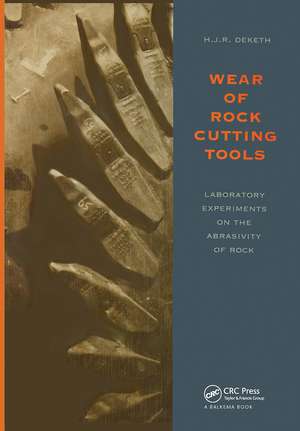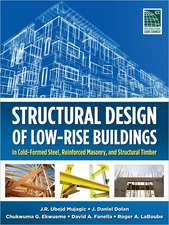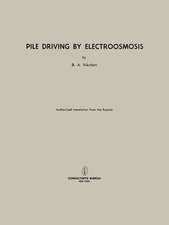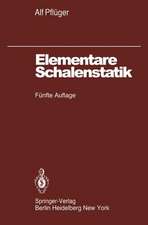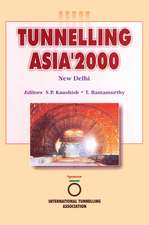Wear of Rock Cutting Tools: Laboratory Experiments on the Abrasivity of Rock
Autor H.J.R. Dekethen Limba Engleză Hardback – 1995
Preț: 892.65 lei
Preț vechi: 1088.59 lei
-18% Nou
Puncte Express: 1339
Preț estimativ în valută:
170.80€ • 178.82$ • 141.33£
170.80€ • 178.82$ • 141.33£
Carte tipărită la comandă
Livrare economică 05-19 aprilie
Preluare comenzi: 021 569.72.76
Specificații
ISBN-13: 9789054106203
ISBN-10: 9054106204
Pagini: 154
Ilustrații: figs.tabs.
Dimensiuni: 178 x 254 x 11 mm
Greutate: 0.49 kg
Ediția:1
Editura: CRC Press
Colecția CRC Press
ISBN-10: 9054106204
Pagini: 154
Ilustrații: figs.tabs.
Dimensiuni: 178 x 254 x 11 mm
Greutate: 0.49 kg
Ediția:1
Editura: CRC Press
Colecția CRC Press
Cuprins
Preface -- 1 Introduction -- 2 Rock cutting theories -- 3 Possible wear mechanisms at the wear-flat of rock cutting tools -- 3.1 Introduction -- 3.2 Wear type classifications -- 3.2.1 The motion category classification -- 3.2.2 The wear mechanism classification -- 3.3 Wear mechanisms relevant to rock cutting tools -- 3.3.1 Abrasive wear -- 3.3.2 Adhesive wear -- 3.3.3 Sliding wear -- 3.3.4 Total wear due to sliding motion contact -- 4 Wear mode hypothesis -- 4.1 Introduction -- 4.2 Cutting forces -- 4.2.1 Influences of rock material properties on cutting forces -- 4.2.2 Influences of rock mass properties on cutting forces -- 4.2.3 The influence of some operating condition factors on cutting forces -- 4.3 Rock relief strength -- 4.3.1 The influence of rock material strengin properties on relief strength -- 4.3.2 The influence of the geometry of the relief on relief strength -- 4.3.3 Hardness of the mineral grains -- 4.4 Wear mode prevalence -- 5 Rock cutting tests to study wear -- 5.1 Introduction -- 5.2 The scraping test -- 6 Rock properties with respect to wear -- 6.1 Introduction -- 6.1.1 Rock property based rock cutting wear index values -- 6.1.2 Some considerations on the non-intrinsic rock property parameters -- 7 Experiments -- 7.1 Introduction -- 7.2 Scraping test experiments -- 8 Chisels used in the experiments -- 8.1 Introduction -- 8.2 Chisel material -- 8.3 Chisel shape -- 8.4 Thermocouple -- 9 Properties of rock types used in the experiments -- 9.1 Rock material properties -- 9.1.1 Interpretation of the measured and derived rock properties -- 9.2 Rock sample preparation -- 10 Test results on artificial rock (mortar) -- 10.1 Repeatability and the effect of groove spacing -- 10.1.1 Effect of spacing of the grooves, sawn into the rock disc -- 10.1.2 Repeatability of the experiments, with respect to the amount of wear -- 10.2 Scraping test experiments on mortar at constant cutting velocity -- 10.2.1 Experiments on mortar composition I -- 10.2.2 Results of experiments on three mortars of different strength -- 10.2.3 Results of experiments on four mortars of different grain size -- 10.2.4 Results of experiments on three mortars of different volume percentage of abrasive grains -- 10.2.5 Results of experiments on two mortars of different shape of the quartz grains -- 10.2.6 Results of experiments on mortars of different mineral content -- 10.3 Specific wear equations based upon scraping test experiments on morta -- 10.4 Scraping test experiments on mortar with varying cutting velocity -- 10.4.1 Experiments on mortar composition 8 -- 10.4.2 Experiments on different mortars -- 10.5 Comments on the experiments on artificial rock (mortar) -- 11 Test results on natural rock types -- 11.1 Introduction -- 11.2 Experimental results -- 11.2.1 Experiments on sandstones -- 11.2.2 Experiments on limestones -- 11.2.3 Correlation of test results obtained in experiments on artificial or natural rock -- 11.3 Comments on the experiments on natural rock -- 12 Relation of the scraping tests with rock cutting projects in practice -- 12.1 Description of the T-850 rock cutting trencher -- 12.2 Calculation of the feed of a single bit of the T-850 rock cutting trencher -- 12.3 The specific wear in the schnarrtanne granite and the oberdorfer sandstone, predicted on the basis of results from the scraping test experiments -- 12.4 Comparison of the field results with the experimental results -- 13 Conclusions -- 14 Closing remarks and recommendations -- Nomenclature -- List of abbreviations and symbols -- References -- Appendix I: Comparison of porosity values determined by different methods -- Appendix II: Petrographic descripitions -- Appendix III: Momentary cutting forces in tests on Elb-sandstone D.
Notă biografică
Technical University Delft, Section Engineering Geology Delft.
Descriere
This text provides an insight into the wear processes which take place during the cutting of rock with steel cutting tools. Rock cutting experiments in different rock types leading to a new approach to the estimation of rock cutting tool wear are ...
